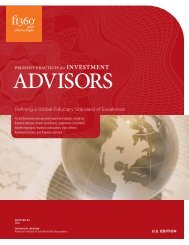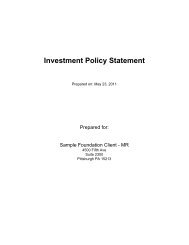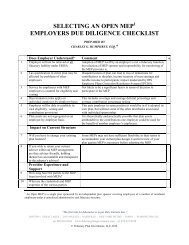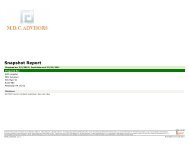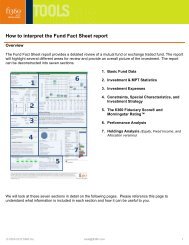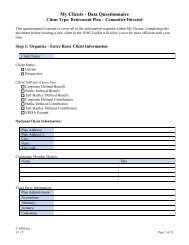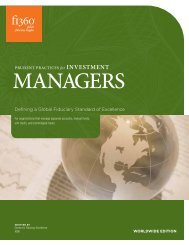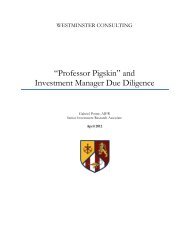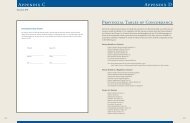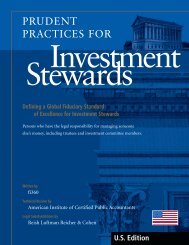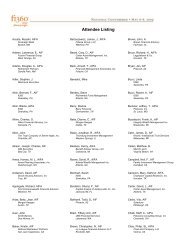404(a)(5) Participant Fee Disclosure - Fi360
404(a)(5) Participant Fee Disclosure - Fi360
404(a)(5) Participant Fee Disclosure - Fi360
Create successful ePaper yourself
Turn your PDF publications into a flip-book with our unique Google optimized e-Paper software.
Peer Group Definitions (Cont.)<br />
Muni Single State Interm<br />
Muni single-state intermediate portfolios invest in bonds issued by state and local governments to fund public projects. The income from such bonds is generally free from federal taxes and from state taxes in the issuing<br />
state. To get the state-tax benefit, these portfolios buy bonds from only one state. These portfolios have durations of 4.5 to seven years (or, if duration is unavailable, average maturities of five to 12 years).<br />
Real Estate<br />
Real estate portfolios invest primarily in real estate investment trusts of various types. REITs are companies that develop and manage real estate properties. There are several different types of REITs, including<br />
apartment, factory-outlet, health-care, hotel, industrial, mortgage, office, and shopping center REITs. Some portfolios in this category also invest in real estate operating companies.<br />
Small Blend<br />
Small-blend portfolios favor U.S. firms at the smaller end of the market-capitalization range. Some aim to own an array of value and growth stocks while others employ a discipline that leads to holdings with valuations<br />
and growth rates close to the small-cap averages. Stocks in the bottom 10% of the capitalization of the U.S. equity market are defined as small-cap. The blend style is assigned to portfolios where neither growth nor<br />
value characteristics predominate.<br />
Small Value<br />
Small-value portfolios invest in small U.S. companies with valuations and growth rates below other small-cap peers. Stocks in the bottom 10% of the capitalization of the U.S. equity market are defined as small-cap.<br />
Value is defined based on low valuations (low price ratios and high dividend yields) and slow growth (low growth rates for earnings, sales, book value, and cash flow).<br />
World Stock<br />
World-stock portfolios have few geographical limitations. It is common for these portfolios to invest the majority of their assets in the U.S., Europe, and Japan, with the remainder divided among the globe's smaller<br />
markets. These portfolios typically have 20%-60% of assets in U.S. stocks.<br />
Prepared for: Fourth Ave. Associates 401k<br />
Page 13 of 19<br />
Analysis, search process, and layout are © 2000-2014, fi360, Inc. (www.fi360.com). All rights reserved. The analysis and opinions generated by fi360: (1) do not constitute professional investment advice; (2) are provided solely for informational purposes; (3) are not warranted or<br />
represented to be correct, complete, or accurate; and (4) are for the exclusive use of subscribers to fi360. The data source is © 2014 Morningstar, Inc. All rights reserved. The data contained herein: (1) is proprietary to Morningstar, Inc and/or its content providers; (2) may not be<br />
copied or distributed; and (3) is not warranted to be accurate, complete or timely. Neither Morningstar, Inc nor its content providers are responsible for any damages or losses arising from any use of this information. Past performance is no guarantee of future results.<br />
fi360_Landscape_v6_0<br />
Fund data as of 1/31/2014 | Holdings as of 01/31/2014



